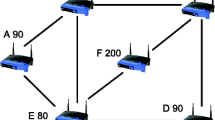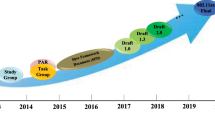Abstract
Over the past few years, wireless networking technologies have made vast forays into our daily lives. Today, one can find 802.11 hardware and other personal wireless technology employed at homes, shopping malls, coffee shops and airports. Present-day wireless network deployments bear two important properties: they are unplanned, with most access points (APs) deployed by users in a spontaneous manner, resulting in highly variable AP densities; and they are unmanaged, since manually configuring and managing a wireless network is very complicated. We refer to such wireless deployments as being chaotic.
In this paper, we present a study of the impact of interference in chaotic 802.11 deployments on end-client performance. First, using large-scale measurement data from several cities, we show that it is not uncommon to have tens of APs deployed in close proximity of each other. Moreover, most APs are not configured to minimize interference with their neighbors. We then perform trace-driven simulations to show that the performance of end-clients could suffer significantly in chaotic deployments. We argue that end-client experience could be significantly improved by making chaotic wireless networks self-managing. We design and evaluate automated power control and rate adaptation algorithms to minimize interference among neighboring APs, while ensuring robust end-client performance.
Similar content being viewed by others
References
D. Aguayo, J. Bicket, S. Biswas, G. Judd and R. Morris, Link-level measurements from an 802.11b Mesh network, in: Proceedings ACM SIGCOMM (2004) pp. 121–132.
A. Akella, R. Karp, S. Seshan, S. Shenker and C. Papadimitriou, Selfish behavior and stability of the internet: A game-theoretic analysis of TCP, in: Proceedings ACM SIGCOMM (2002) pp. 117–130.
Alcatel, AirView Software, http://www.alcatel.com.
Y. Cheng, Y. Chawathe, A. LaMarca and J. Krumm, Accuracy characterization for metropolitan-scale Wi-Fi localization, in: Proceedings MobiSys (2005) pp. 233–245.
D. Chiu and R. Jain, Analysis of the increase/decrease algorithms for congestion avoidance in computer networks, Computer Networks and ISDN Systems 17 (1989) 1–14.
D. Clark, C. Partridge, J. Ramming and J. Wroclawski, A knowledge plane for the internet, in: Proceedings ACM SIGCOMM (2003) pp. 3–10.
Datacomm Research, New Datacomm Research Report: Wireless LAN Equipment Shipments to Triple Within Five Years, http://www.tmcnet.com/usubmit/2005/Feb/1120138.htm.
R. Draves, J. Padhye and B. Zill, Comparison of routing metrics for static multi-hop wireless networks, in: Proceedings ACM SIGCOMM (2004) pp. 133–144.
R. Droms, Dynamic host configuration protocol, Technical report, Internet Engineering Task Force. RFC 2131.
A. Hills, Large-scale wireless LAN design, IEEE Communications 39 (2001) 98–104.
G. Holland, N. Vaidya and P. Bahl, A rate-adaptive MAC protocol for multi-hop wireless networks, in: Proceedings ACM MobiCom (2003) pp. 236–251.
IEEE, OUI and Companyid assignments, http://standards.ieee.org/regauth/oui/oui.txt.
Instat/MDR, 3Q 2004 WLAN Market Share Report, http://www.instat.com/r/nrep/2004/IN0401429WL.htm.
Intego, WI-Fi Locator, http://www.intego.com/wiFiLocator/.
Intel Research Seattle, Place Lab: A Privacy-Observant Location System, http://placelab.org/.
JIwire, WI-FI Hotspot locator, http://jiwire.com.
G. Judd and P. Steenkiste, Using emulation to understand and improve wireless networks and applications, in: Proceedings USENIX NSDI (2005).
V. Kawadia and P.R. Kumar, Principles and protocols for power control in Ad Hoc networks, IEEE Journal on Selected Areas in Communications 1 (2005) 5–16.
R. Kompella and A. Snoeren, SPARTA: Scheduled power and rate adaptation, in: ACM SenSys (2003).
B. Mah, An empirical model of HTTP network traffic, in: Proceedings IEEE Infocom (1997) pp. 592–600.
J. Malinen, Host AP Driver, http://hostap.epitest.fi/.
Propagate Networks, Autocell, http://www.propagatenetworks.com/product/.
D. Qiao, S. Choi, A. Jain and K. Shin, MiSer: An optimal low-energy transmission strategy for IEEE 802.11a/h, in: Proceedings ACM MobiCom (2003) pp. 161–175.
A. Rao and I. Stoica, An overlay MAC layer for 802.11 networks, in: Proceedings MobiSys (2005) pp. 135–148.
T. Rappaport, Wireless Communications: Principles and Practice (Prentice-Hall, Englewood Cliffs, NJ, 1996).
J. Rexford, A. Greenberg, G. Hjalmtysson, A. Myers, G. Xie, J. Zhan and H. Zhang, Network-wide decision making: Toward a wafer-thin control plane, in: Proceedings ACM SIGCOMM HotNets-III.
B. Sadeghi, V. Kanodia, A. Sabharwal and E. Knightly, Opportunistic media access for multi-rate Ad Hoc networks, in: Proceedings ACM MobiCom (2002) pp. 24–35.
A. Santhanam and R. Cruz, Optimal routing, link scheduling and power control in multi-hop wireless networks, in: Proceedings IEEE Infocom (2003) pp. 702–711.
Strix Systems, AccessOne/Network OWS, http://www.strixsystems.com/products/products_main.asp.
S. Thomson and T. Narten, IPv6 Stateless Address Autoconfiguration, Technical report, Internet Engineering Task Force. RFC 2462.
V. van der Vegt, Auto Rate Fallback, http://www.phys.uu.nl/vdvegt/docs/gron/node24.html.
Wi-Fi-Zones.com, Find more hotspot locations, http://www.wi-fi-zones.com.
Wifi Maps.com, Wardriving Maps and Hotspot Locator, http://www.wifimaps.com.
X. Zeng, R. Bagrodia and M. Gerla, Global Mobile Information Systems Simulation Library, http://pcl.cs.ucla.edu/projects/glomosim/.
ZeroConf, IETF Zero configuration Networking Working Group, http://www.ietf.org/html.charters/zeroconf-charter.html.
Author information
Authors and Affiliations
Corresponding author
Additional information
This work was supported by the Army Research Office under grant number DAAD19-02-1-0389, and by the NSF under grant numbers ANI-0092678, CCR-0205266, and CNS-0434824, as well as by IBM and Intel.
Aditya Akella obtained his Ph.D. in Computer Science from Carnegie Mellon University in September 2005. He obtained a B.Tech in Computer Science and Engineering from IIT Madras in May 2000. Currently, Dr. Akella is a post-doctoral associate at Stanford University. He will join the Computer Sciences faculty at the University of Wisconsin-Madison in Fall 2006. Dr. Akella's research interests include Internet Routing, Network Protocol Design, Internet Security, and Wireless Networking. His web page is at http://www.cs.wisc.edu/~akella.
Glenn Judd, is a Computer Science Ph.D. candidate at Carnegie Mellon University. His research interests include wireless networking and pervasive computing. He has an M.S. and B.S. in Computer Science from Brigham Young University.
Srinivasan Seshan is currently an Associate Professor and holds the Finmeccanica chair at Carnegie Mellon University’s Computer Science Department. Dr. Seshan received his Ph.D. in 1995 from the Computer Science Department at University of California, Berkeley. From 1995 to 2000, Dr. Seshan was a research staff member at IBM’s T.J. Watson Research Center. Dr. Seshan’s primary interests are in the broad areas of network protocols and distributed network applications. In the past, he has worked on topics such as transport/routing protocols for wireless networks, fast protocol stack implementations, RAID system design, performance prediction for Internet transfers, Web server benchmarking, new approaches to congestion control, firewall design and improvements to the TCP protocol. His current work explores new approaches in overlay networking, sensor networking, online multiplayer games and wide-area Internet routing. His web page is at http://www.cs.cmu.edu/~srini.
Peter Steenkiste is a Professor of Computer Science and of Electrical and Computer Engineering at Carnegie Mellon University. His research interests include networking, distributed systems, and pervasive computing. He received an M.S. and Ph.D. in Electrical Engineering from Stanford University and an Engineering degree from the University of Gent, Belgium. You can learn more about his research from his home page http://www.cs.cmu.edu/~prs.
Rights and permissions
About this article
Cite this article
Akella, A., Judd, G., Seshan, S. et al. Self-management in chaotic wireless deployments. Wireless Netw 13, 737–755 (2007). https://doi.org/10.1007/s11276-006-9852-4
Published:
Issue Date:
DOI: https://doi.org/10.1007/s11276-006-9852-4




